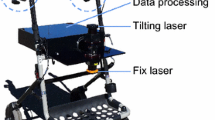Abstract
Elderly blind people with walking disabilities have difficulties in using common navigation aids like the white cane or a guide dog. Therefore, a smart walker was developed to provide walking assistance and transmit the surrounding information of the position of surrounding objects. The handicapped receive the information via haptic feedback to avoid collisions. Obstacles are detected by a laser range finder and information of the obstacle position is transmitted to the user via a group of vibration motors on a belt around the waist. A self-rotating map was involved to display the global setting and help preplanning the route. First experiments show that after a short training period user can safely avoid collisions with obstacles in a test course.
The original version of this chapter was inadvertently published with an incorrect chapter pagination 602–607 and DOI 10.1007/978-3-319-32703-7_117. The page range and the DOI has been re-assigned. The correct page range is 608–613 and the DOI is 10.1007/978-3-319-32703-7_118. The erratum to this chapter is available at DOI: 10.1007/978-3-319-32703-7_260
An erratum to this chapter can be found at http://dx.doi.org/10.1007/978-3-319-32703-7_260
Access this chapter
Tax calculation will be finalised at checkout
Purchases are for personal use only
Preview
Unable to display preview. Download preview PDF.
Similar content being viewed by others
References
K. Möller, J. Möller, K. O. Arras et al. (2009) Enhanced perception for visually impaired people evaluated in a real time setting, World Congress on Medical Physics and Biomedical Engineering, Munich, Germany, 2009, 283-6
D. Dakopoulos and N. G. Bourbakis (2010) Wearable Obstacle Avoidance Electronic Travel Aids for Blind: A Survey. Systems, Man, and Cybernetics, Part C: Applications and Reviews, IEEE Transactions on 40:25-35
D. Pascolini and S. P. Mariotti (2012) Global estimates of visual impairment: 2010. Br J Ophthalmol 96:614-8
A. Wachaja, P. Agarwal, M. Zink et al. (2015) Navigating Blind People with a Smart Walker, International Conference on Intelligent Robots and Systems, Hamburg, Germany, 2015
R. Velázquez (2010), “Wearable Assistive Devices for the Blind” in Wearable and Autonomous Biomedical Devices and Systems for Smart Environment. Springer Berlin Heidelberg, 331-49
F. A. Geldard (1960) Some neglected possibilities of communication. Science 131:1583-8
F. A. Geldard and C. E. Sherrick (1965) Multiple Cutaneous Stimulation: The Discrimination of Vibratory Patterns. J Acoust Soc Am 37:797-801
E. C. Lechelt (1986) Sensory-substitution systems for the sensorily impaired: the case for the use of tactile-vibratory stimulation. Percept Mot Skills 62:356-8
M. Zöllner, S. Huber, H.-C. Jetter et al. (2011), “NAVI – A Proof-of-Concept of a Mobile Navigational Aid for Visually Impaired Based on the Microsoft Kinect” in Human-Computer Interaction – INTERACT 2011. Springer Berlin Heidelberg, 584-7
R. Velazquez, E. E. Pissaloux, J. C. Guinot et al. (2005) Walking Using Touch: Design and Preliminary Prototype of a Non-Invasive ETA for the Visually Impaired, Engineering in Medicine and Biology Society, 2005. IEEE-EMBS 2005. 27th Annual International Conference of the, 2005, 6821-4
L. A. Johnson and C. M. Higgins (2006) A Navigation Aid for the Blind Using Tactile-Visual Sensory Substitution, Engineering in Medicine and Biology Society, 2006. EMBS ‘06. 28th Annual International Conference of the IEEE, 2006, 6289-92
S. K. Nagel, C. Carl, T. Kringe et al. (2005) Beyond sensory substitution–learning the sixth sense. J Neural Eng 2:R13-26
P. Bach-y-Rita, C. C. Collins, F. A. Saunders et al. (1969) Vision substitution by tactile image projection. Trans Pac Coast Otoophthalmol Soc Annu Meet 50:83-91
J. van Erp (2005) Vibrotactile spatial acuity on the torso: effects of location and timing parameters, Eurohaptics Conference, 2005 and Symposium on Haptic Interfaces for Virtual Environment and Teleoperator Systems, 2005. World Haptics 2005. First Joint, 2005, 80-5
M. Srikulwong and E. O’Neill (2010), “A Comparison of Two Wearable Tactile Interfaces with a Complementary Display in Two Orientations” in Haptic and Audio Interaction Design. Springer Berlin Heidelberg, 139-48
J. Gual Ortí, M. Puyuelo Cazorla, and J. Lloveras Macià (2012) Analysis of volumetric tactile symbols produced with 3D printing, The Fifth International Conference on Advances in Computer-Human Interactions, Valencia, 2012, 60-7
V. Vovzenílek, M. Kozáková, Z. vSt’ávová et al. (2009) 3D Printing Technology in Tactile Maps Compiling, Proc. 24th International Cartographic Conference, Santiago de Chile, 2009
M. Quigley, K. Conley, B. Gerkey et al. (2009) ROS: an open-source Robot Operating System. ICRA workshop on open source software 3:5
Author information
Authors and Affiliations
Corresponding author
Editor information
Editors and Affiliations
Rights and permissions
Copyright information
© 2016 Springer International Publishing Switzerland
About this paper
Cite this paper
Reyes Adame, M., Yu, J., Moeller, K. (2016). Mobility Support System for Elderly Blind People with a Smart Walker and a Tactile Map. In: Kyriacou, E., Christofides, S., Pattichis, C. (eds) XIV Mediterranean Conference on Medical and Biological Engineering and Computing 2016. IFMBE Proceedings, vol 57. Springer, Cham. https://doi.org/10.1007/978-3-319-32703-7_118
Download citation
DOI: https://doi.org/10.1007/978-3-319-32703-7_118
Published:
Publisher Name: Springer, Cham
Print ISBN: 978-3-319-32701-3
Online ISBN: 978-3-319-32703-7
eBook Packages: EngineeringEngineering (R0)




